The words “full moon” in many languages

It is said that there are more than 6,000 languages worldwide (this is hard to imagine) and it is a fascinating concept to think, there are probably as many words for “full moon”.
Here we begin our little journey to the full moon. A few words about the fascinating quest of the greater purpose, that includes the full moon circulating through our lives. In layman’s terms and not always scientific (astronomy experts – don’t look too closely!). We would like to wish you illuminating moments. Enjoy!


It is said that there are more than 6,000 languages worldwide (this is hard to imagine) and it is a fascinating concept to think, there are probably as many words for “full moon”.
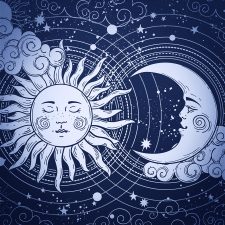
A full moon is when the Sun and the Moon are facing opposite, being in opposite direction from an Earth perspective.
This might feel astonishing if one imagines that the Moon is on one side, the Sun on the other and the Earth in between? Shouldn’t the Earth throw a shadow onto the Moon? Bingo – this is exactly what she does! But only when the Moon is exactly on the Earth orbit, the so called “ecliptic”. When this takes place, we speak of a lunar eclipse!
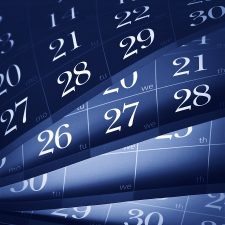
The Moon needs 27.33 days to circle around the Earth. Something that is also referred to as “sidereal time”. But because the Earth orbits the Sun, just like the Moon orbits the Earth, the Moon has to travel two further days in order to resume the same position to the Earth and Sun. This is then called the “sidereal time”. In order to determine the point of time of the reoccurring full moon, the sidereal time serves as basis.

We already know now that the moon month is mostly shorter than the calendar month, being on average approximately 29.5 days. If full moon falls on the first or second of a month, it is possible that another full moon occurs in the same month, for instance in July 2004:
Friday, 2 July 2004, 01:08:54 pm
Saturday, 31 July 2004, 08:05:06 pm
This event is also known as “blue moon”.

The answer is: “everywhere at the same time”. This refers to the so called Universal Time (UT) though, which is used for general astronomical events. We have already learnt that full moon is an astronomical event, where the moon, sun and the earth play a role by being in a specific position. So, full moon takes place at a specific time in the outer space. This point of time is specified by astronomers namely by the Universal Time.

There are multiple ways of approaching this question. If we look at it from a purely theoretical standpoint, we might be tempted to say that the full moon is infinitely short, since the phases of the moon are changing continuously. The moon is not yet quite full shortly before the full moon, and is already waning shortly afterwards.
However, there is a practical aspect that lets us quantify the full moon as a finite and measurable span of time: Since the Sun is significantly bigger than the Moon, its rays are able to reach just a little over half of the Moon’s surface. This means that the timespan in which the visible side of the Moon’s surface is irradiated (as seen from Earth) is longer than infinitely short.

Whether scientists, astrologers or esoterics, they agree on one thing: the moon influences earth and life on earth. For instance, it regulates the tides through its magnetism. Also continents feel the consequence of this magnetism and either raise or lower their position sometimes up to 26 cm.

In nature it is a known fact: for some animal species, mating takes place at full moon. However, the examples that can be found on this subject are rather simple. Full moon serves in some cases indirectly as the cause (for instance through the high water levels during the tides that the horseshoe crab uses to deposit its eggs) or also as the signal for both sexes of a species to begin at the exact same time to safeguard their future existence (a particular type of fly or also corals). It is understood that also wolves are led by full moon when it is time to mate.

… that people are looking for an argument at full moon or are especially happy …
… that if full moon is surrounded by a haze, a person dies …
… that you raise your hat three times to the moon (being a man) or you make a curtsey (being a woman), in order to protect yourself from misfortune until the next full moon …
… that whoever does not chink glasses with full moon at least once, does not deserve any happiness [Greek toast] …
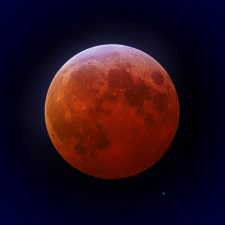
During a lunar eclipse, the Moon moves through the shadow of the Earth. Which means, that the Earth is positioned quite exactly between the Sun and Moon and casts its shadow onto the Moon. This is only possible at full moon and if some other requirements are met. Depending on whether the moon passes the partial or the core shadow of the Earth, we speak of a partial or total lunar eclipse.
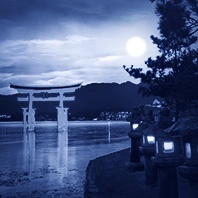
Japan has a custom, which is called “Tsukimi” or also “Otsukimi” that literally means “moon-viewing” (tsuki = jap. Moon). This tradition dates back to the Heian period (794–1192) where Japanese culture and the arts were refined to a high degree. At that time, elements of the Chinese “Mid-Autumn Moon Festival” were introduced in Japan, and festivals and rituals were held in the eighth sun month (which corresponds to September in our current calendar).

Towards the end of the 18th century, over 200 years ago, Germany was about to be conquered by a new style of painting: the romanticism. The objective was, just as we understand it today, to emphasise feelings. But it was much more than this …
It was about the self-conception of an entire generation of artists, poets and musicians, who were trying to oppose the, up until then, reigning reason of the enlightenment era and also the classicism that was concerned with order. They countered with irrational contents i.e. fantasy, infinity or transcendency. It was what Wassily Kandinsky (1866–1944) expressed about the artist in general at a much later point in time: “The fortune of an artist is the possibility, to express longing in forms.”
Jellyfish are fascinating beings and although, nobody would actually like to come into contact with them, we are mesmerized by them and admire their shapes, colors and almost etheric bodies, which are floating through the water – like entities from another world. And lo behold, there is also one kind that the Moon lent his name to: the »moon jellyfish« (lat. aurelia aurita).
Also in various other languages, you can find the word »moon« in the name these jellyfish:
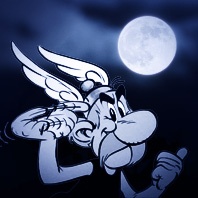
Who doesn’t know them, the fearless Gauls Asterix and Obelix, who have been making the hearts of comic fans leap for joy since decades and who impress again and again through witty texts and masterful drawings. The stories originate from the pen of the French illustrator Albert Uderzo (1927–2020), who created, together with his fellow countryman René Goscinny (1926–1977), the first comic in the year 1959, and with that, brought the adventures of the brave Gaul to life.

On Wednesday, 15th June 2011 (or Thursday 16th June for certain time zones) is full moon and a total lunar eclipse at the same time. However, it will only be completely visible in the Near and Middle East. In Asia and Australia, the moon will be already set and in Europe and Africa, the moon will be just rising by the time the lunar eclipse takes place. In America, this event won’t be visible at all.
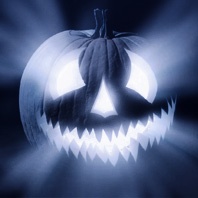
In 2020 the full moon will fall on a 31st October and a Halloween party can take place in the full moon light. The imagination of people fits this well apparently, because no matter where you look, the full moon can be seen in all portrayals of Halloween. In historical terms, there is no connection, however. Halloween is the evening before All Saints’ Day (originally: »All Hallows’ Eve«). The basic idea of this festival is the remembrance of saints and it is connected to the wish to drive out bad spirits. This is how the gruesome costumes came into play.

Bathing during the full moon or in the full moon light, is a fascinating experience, which one or the other has surely made. Two ways to interpret this is either bathing in the water at the full moon (outdoors or in the bath tub), or bathing directly in the moonlight (when the light of the Moon shines onto your skin, just like sunbathing).

There are stories, they are so odd that they are hard to believe. Just a few days ago we came across this report, saying some multi-billionaires teamed up in order to buy the Moon. The motive for this unusual proposal is apparently an investment into future projects. It has been known for some time that the Moon could be significant for future utilization by people, and it therefore becomes a lucrative economic investment.
This is particularly about possible mineral resources, but also about the feasibility of creating moon colonies. Meanwhile, scientific studies have shown that the cultivation of plants – observed over extended periods of time – could create something like an atmosphere containing oxygen around the Moon. This is how a colonization on the Moon would be conceivable and it seems to be almost for certain that there should be enough volunteers, who would be willing to move away from Earth.

Who believes to see a staggering Moon at night, has probably had a drop too much, although a staggering movement of the Moon actually exists in astronomy. This is called »libration«, but happens very slowly and is therefore only visible by the naked eye in time-lapse photography.
The Moon orbits around the Earth in a so called synchronous rotation. This means that it always faces one hemisphere towards the Earth, while the reverse side of the Moon is not visible from Earth. Due to certain physical conditions (relating to orbits, angular velocity, centres of mass, among others), what happens is that the visible surface of the Moon varies slightly during the course of the moon cycle, and there is a gentle change of inclination of the Moon’s axis or it appears to turn a little.
“Full Moon Silhouettes” is an almost 4 minute real time video by the Australian photographer and visual effect artist Mark Gee, where the rise of the full moon is shown, above Mount Victoria lookout in Wellington (New Zealand). You can see an uncut sequence where the Moon rises from the lower right corner above the horizon, and ascends to the left upper side (because this takes place on the southern hemisphere!). The visitors on the lookout are visible as black silhouettes in front of the yellow Moon and its luna maria.